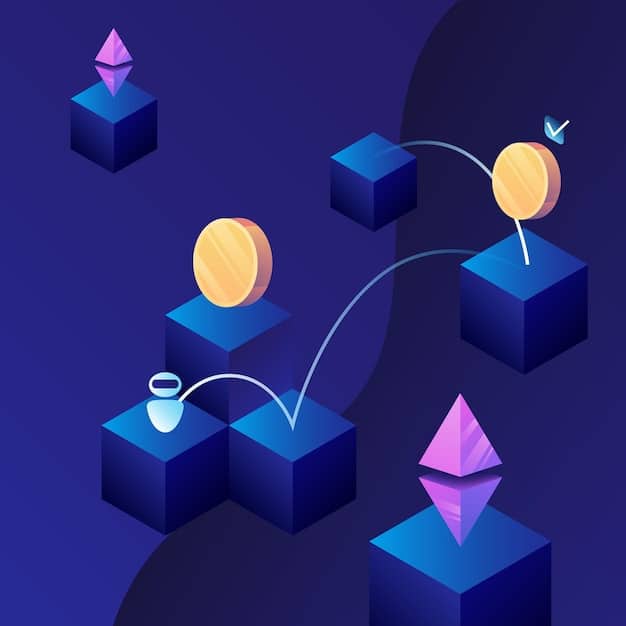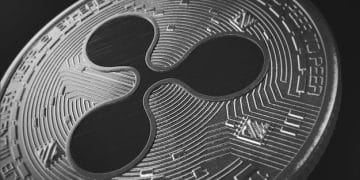Cross-Chain DeFi: Ethereum to Solana for Higher US Yields

Cross-chain DeFi strategies empower users in the US to bridge assets from Ethereum to Solana, opening avenues for potentially higher yields by leveraging the unique opportunities offered by each blockchain ecosystem.
The decentralized finance (DeFi) landscape is continuously evolving, and one of the most exciting developments is the rise of cross-chain functionality. This article delves into the world of cross-chain DeFi: Bridging assets from Ethereum to Solana for higher yields in the US, exploring the opportunities and strategies that can help you maximize your returns.
Understanding Cross-Chain DeFi
Cross-chain DeFi refers to the ability to utilize DeFi applications and protocols across different blockchain networks. This interoperability allows users to move assets seamlessly between chains, opening up new possibilities for yield farming, lending, and borrowing.
What is a Blockchain Bridge?
A blockchain bridge is a technology that enables the transfer of assets and data between two different blockchain networks. It acts as a conduit, allowing users to access the unique features and opportunities available on various chains.
Blockchain bridges are critical components in the cross-chain ecosystem, facilitating the movement of assets and data between disparate networks. These bridges vary in design and security, but they all serve the fundamental purpose of enabling interoperability between blockchains.

Why Bridge from Ethereum to Solana?
Bridging from Ethereum to Solana offers several advantages, primarily related to speed, cost, and yield opportunities. Ethereum, while a foundational blockchain for DeFi, can suffer from high transaction fees and slower processing times. Solana, on the other hand, provides significantly faster and cheaper transactions.
- Speed: Solana’s high throughput allows for near-instantaneous transactions, drastically reducing wait times compared to Ethereum.
- Cost: Transaction fees on Solana are a fraction of those on Ethereum, making it more economical for frequent trading and yield farming.
- Yield Opportunities: Solana-based DeFi protocols often offer attractive yields due to lower costs and higher efficiency.
Bridging assets from Ethereum to Solana can be a strategic move for DeFi users looking to optimize their returns by leveraging the benefits of both ecosystems.
Popular Bridges for Ethereum to Solana Transfers
Several bridges facilitate the transfer of assets between Ethereum and Solana. Each bridge has its own set of characteristics, including supported assets, fees, and security mechanisms.
Wormhole
Wormhole is a widely used bridge that supports a variety of assets, including stablecoins, ERC-20 tokens, and NFTs. It uses a cross-chain messaging protocol to verify and execute transactions across different chains.
Wormhole’s architecture involves a network of guardians who observe and validate transactions on both Ethereum and Solana, ensuring the secure transfer of assets.
Allbridge
Allbridge focuses on bridging stablecoins between different chains, offering a seamless and cost-effective way to move stable assets between Ethereum and Solana.
Allbridge utilizes a liquidity pool model, where users can deposit and withdraw stablecoins, earning fees in the process. This model helps maintain liquidity and stability for cross-chain transfers.
Solana Wormhole Token Bridge
The Solana Wormhole Token Bridge is a direct bridge that allows for the transfer of tokens between Ethereum and Solana, specifically designed for assets within the Wormhole ecosystem.
- Direct Transfers: Facilitates direct transfers between Ethereum and Solana without intermediaries.
- Wormhole Ecosystem: Primarily used for tokens within the Wormhole ecosystem, ensuring compatibility.
- Security: Leverages Wormhole’s security architecture for safe and reliable transfers.
Choosing the right bridge depends on the specific assets you want to transfer and your risk tolerance, as each bridge has its own security and fee structure.
Strategies for Maximizing Yields on Solana
Once you’ve bridged your assets from Ethereum to Solana, you can explore various DeFi strategies to maximize your yields. Solana’s ecosystem offers a range of opportunities, including yield farming, lending, and providing liquidity.
Yield Farming on Raydium
Raydium is a decentralized exchange (DEX) and automated market maker (AMM) built on Solana. It allows users to earn rewards by providing liquidity to trading pairs.
To participate in yield farming on Raydium, you need to deposit tokens into liquidity pools, providing liquidity for traders. In return, you receive LP tokens, which represent your share of the pool. These LP tokens can then be staked to earn RAY, Raydium’s native token, as a reward.
Lending and Borrowing on Solend
Solend is a lending and borrowing protocol on Solana that allows users to lend their assets and earn interest, or borrow assets by providing collateral.

By lending your assets on Solend, you can earn passive income in the form of interest. The interest rates are determined by the supply and demand of each asset. If you need to borrow assets, you can do so by providing collateral, which ensures the lender is protected.
Providing Liquidity on Orca
Orca is an AMM on Solana that focuses on providing a user-friendly and efficient trading experience. It offers liquidity pools with low slippage and attractive yields.
- User-Friendly: Easy to navigate and use, making it accessible to both beginners and experienced DeFi users.
- Efficient Trading: Optimized for low slippage, ensuring users get the best possible prices for their trades.
- Attractive Yields: Competitive yields for liquidity providers, incentivizing participation.
By providing liquidity on Orca, you can earn trading fees and participate in liquidity mining programs, further boosting your yields.
Risks Associated with Cross-Chain DeFi
While cross-chain DeFi offers exciting opportunities, it’s essential to be aware of the associated risks. These risks can include bridge vulnerabilities, smart contract risks, and impermanent loss.
Bridge Vulnerabilities
Blockchain bridges are complex systems and can be vulnerable to exploits. A successful attack on a bridge can result in the loss of funds for users transferring assets.
Bridge vulnerabilities can arise from design flaws, coding errors, or compromised security keys. It is crucial to use bridges that have been thoroughly audited and have a proven track record of security.
Smart Contract Risks
DeFi protocols rely on smart contracts, which are susceptible to bugs and vulnerabilities. A flaw in a smart contract can lead to the loss of funds or unexpected behavior.
Before participating in any DeFi protocol, it’s essential to research the smart contracts and ensure they have been audited by reputable security firms. Audits help identify and mitigate potential vulnerabilities, reducing the risk of exploits.
Impermanent Loss
Impermanent loss is a risk associated with providing liquidity to AMMs. It occurs when the value of the tokens in a liquidity pool diverges, resulting in a loss compared to simply holding the tokens.
- Token Divergence: When the price of one token in a liquidity pool increases or decreases significantly relative to the other token.
- Loss Comparison: Results in a lower value compared to holding the tokens separately, especially during volatile periods.
- Mitigation Strategies: Can be mitigated by choosing stablecoin pairs or using insurance protocols that cover impermanent loss.
Understanding and managing impermanent loss is crucial for successful yield farming and liquidity provision.
Regulatory Landscape in the US
The regulatory landscape for DeFi in the US is still evolving, and it’s essential to stay informed about the latest developments. Regulatory uncertainty can impact the availability and legality of certain DeFi activities.
Current Regulations
Current regulations primarily focus on anti-money laundering (AML) and securities laws. DeFi protocols that facilitate the trading of unregistered securities may face regulatory scrutiny.
The Securities and Exchange Commission (SEC) has been actively investigating and taking enforcement actions against DeFi protocols that offer unregistered securities. It’s crucial to ensure that any DeFi activities comply with existing securities laws.
Future Regulations
Future regulations may address specific aspects of DeFi, such as stablecoins, lending protocols, and cross-chain functionality. These regulations could impact the way DeFi protocols operate and the types of activities that are permitted.
Staying informed about potential regulatory changes is crucial for DeFi users and developers. Regulatory clarity can provide a more stable and predictable environment for the growth of the DeFi ecosystem.
Impact on Cross-Chain DeFi
Regulatory actions could significantly impact cross-chain DeFi, affecting the availability of bridges and the types of assets that can be transferred. Regulatory scrutiny may also increase the compliance costs for cross-chain protocols, potentially impacting yields and user experience.
Despite potential regulatory hurdles, the demand for cross-chain functionality is likely to continue growing. DeFi users are increasingly seeking access to diverse opportunities across different blockchain networks, which could drive the development of more compliant and secure cross-chain solutions.
Step-by-Step Guide for Bridging Assets
Bridging assets from Ethereum to Solana involves several steps, including choosing a bridge, connecting your wallets, and executing the transfer. Here’s a step-by-step guide to help you navigate the process.
Choosing a Bridge
Select a bridge that supports the assets you want to transfer and offers a balance of security, cost, and convenience. Consider factors such as the bridge’s reputation, audit history, and user reviews.
Research and compare different bridges to find the one that best suits your needs. Look at factors like supported assets, fees, security measures, and user reviews to make an informed decision.
Connecting Your Wallets
Connect your Ethereum and Solana wallets to the chosen bridge. Ensure that you are using reputable wallets that support both networks, such as MetaMask for Ethereum and Phantom or Solflare for Solana.
Follow the bridge’s instructions to connect your wallets securely. Double-check the wallet addresses and ensure they are correct before proceeding with the transfer.
Executing the Transfer
Initiate the transfer on the bridge platform, specifying the amount of assets you want to transfer and the destination Solana address. Review the transaction details carefully and confirm the transfer.
- Specify Amount: Enter the exact amount of assets you wish to transfer from Ethereum to Solana.
- Destination Address: Provide the correct Solana wallet address where the assets should be sent.
- Review Details: Double-check all transaction details, including fees and estimated arrival time.
Once the transfer is confirmed, the bridge will lock your assets on Ethereum and mint corresponding tokens on Solana. The transfer time can vary depending on the bridge and network conditions.
| Key Point | Brief Description |
|---|---|
| 🚀 Cross-Chain DeFi | Involves using DeFi protocols across different blockchains for higher yields. |
| 🌉 Ethereum to Solana | Bridges enable asset transfers, leveraging Solana’s speed and low costs. |
| ⚠️ Risks | Include bridge vulnerabilities, smart contract exploits, and impermanent loss. |
| ⚖️ Regulations | Evolving US regulations can impact the availability and legality of DeFi activities. |
FAQ
▼
Cross-chain DeFi refers to the use of decentralized finance applications across multiple blockchain networks, enhancing interoperability and potential yield farming opportunities.
▼
Bridging assets to Solana offers advantages like faster transaction speeds, lower fees, and unique yield opportunities within the Solana ecosystem compared to Ethereum.
▼
Popular bridges include Wormhole, Allbridge, and the Solana Wormhole Token Bridge, each offering different features and security measures for transferring assets.
▼
Risks include vulnerabilities in blockchain bridges, smart contract exploits, impermanent loss, and regulatory uncertainty, requiring careful risk management strategies.
▼
Staying updated involves monitoring regulatory announcements from agencies like the SEC and CFTC, and consulting with legal experts experienced in digital assets.
Conclusion
Cross-chain DeFi presents a promising frontier for DeFi users in the US, offering opportunities to unlock higher yields by leveraging the unique strengths of different blockchain networks like Ethereum and Solana. However, it’s crucial to approach this space with caution, understanding the associated risks and staying informed about the evolving regulatory landscape. By carefully evaluating your options and implementing robust risk management strategies, you can navigate the complexities of cross-chain DeFi and potentially achieve your financial goals.





